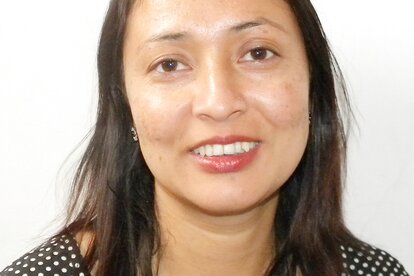It is early spring, and most of the polytunnels now contain only small seedlings and the fields are bare of flowers. Back in the autumn, however, the place was a riot of color – predominantly the orange of marigolds. Much used in Nepal for making flower garlands, there is a high demand for marigolds throughout the year, but especially in the autumn. Flower garlands are used to welcome guests, to wish safe travel to loved ones leaving on a journey, to offer at temples – and, most importantly, to garland family members and the family home over the festival of Tihar. Occurring sometime in the period mid-October to mid-November (depending on the lunar calendar), Tihar marks the peak demand for floriculture production.
A new business opportunity
Commercial floriculture in Nepal, especially in the hills, is a relatively recent phenomenon. In the past, most flower garlands sold in urban areas were sourced from India. However, the local commercial potential is increasingly apparent. Such ventures are being encouraged by the Nepal Agricultural Services Development Project (Prayas) – a joint program of the Government of Nepal and the Swiss Agency for Development and Cooperation, implemented with technical support from Helvetas. Under Nepal’s federal system, which became operational in 2017 following democratic elections, municipalities are responsible for agricultural extension. The project therefore supports selected municipalities in developing such services: one such rural municipality (gaunpalika) is that of Sunkoshi (Sindhuli).

Rajendra Bhattarai was born and grew up in what is now Sunkoshi rural municipality. Seeing no future for himself in the village, he took a large loan to get a driving license, pay the fees of a foreign employment agency, and travel to Dubai to work as a driver. Unfortunately, he poorly understood the driving rules in the country, and was often fined. Often, he ended up paying more than he saved each month, so he decided to come home with the small amount of money that he had made. Back in the village, he pondered his options with his friend Madhusudan Rana, who had also left the village seeking better options - but who had returned to his roots following the collapse of his Kathmandu-based business. The two friends (pictured here just before the end of the marigold harvest) saw a television program about the money to be made in floriculture in Thailand and wondered about such possibilities in Nepal.
Training and regular advisory support
In devising their agriculture development plan with Prayas support, staff in Sunkoshi rural municipality also identified floriculture as a potentially promising commercial option. They organized a seven-day training at a Flower Development Center, which both Bhattarai and Rana attended.
“The training taught us how to produce flowers in accordance with the market demand so that we would limit losses. We realized that we had to maintain a continuous cycle of flower production, with Tihar being the last point of harvesting. After that, another cultivation session should begin.”
The training also provided information about nursery techniques, the importance of cultivation under polytunnels to maintain favorable temperature and moisture levels, how to keep the use of pesticides to a minimum, and the best varieties of marigold to grow.
“Once we learned all this from the rural municipality’s people, we became aware about the potential market and how 75% of flowers marketed in Nepal come from India. This meant we have a huge market nearby and in Kathmandu Valley.”
Rana began by cultivating a plot a little less than 0.25 hectares, and in four months he made a net profit of NRs 300,000 (about USD 2,300) – far more than he could make with other crops. He and Bhattarai have now formed a farmer’s group cultivating flowers on about 2 hectares. They acknowledge that this is in part through hard work, but in part also because they receive regular advice through the municipality.
“Technical personnel come here often, fortnightly or monthly. We are always in touch with them. Through them we have linkages to the market. They inform us where the demand is, and we send our produce accordingly.”
Investing locally, generating employment locally
Sunkoshi rural municipality has every reason to support farmers such as Rana and Bhattarai, who are reversing the trend of people leaving rural areas to make money elsewhere. The farmers not only run a thriving enterprise that is locally registered and pays local taxes; they have also become a source of local employment. Last Tihar, the farmer’s group employed 60 people in harvesting the flowers; six women are employed throughout the year. For Rana and Bhatterai, this is a source of pride – but most of all, they are glad to be earning good money whilst living at home and being able to afford schooling for their children.
This blog follows from an earlier one about the challenges of agriculture in Nepal’s hills. Rana and Bhattarai may be exceptional entrepreneurs, but they demonstrate that with relatively small amounts of technical support, business-minded individuals can trigger livelihood opportunities for others as well. Over 220 returnee migrants have already established successful enterprises through such support, facilitated through Prayas.



